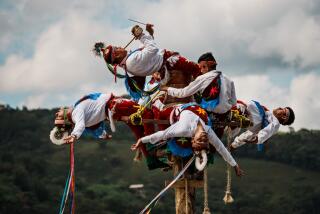A Timeless Ritual From Java : Culture: Royal court dancers will perform programs rich in island heritage beginning today at the Arboretum.
- Share via
JOGJAKARTA, Central Java — Flanked by statues of giants, symbols of human passion, the massive Danapratapa Gate of the Sultan’s Palace (or Kraton) dominates a courtyard gleaming with antique splendor.
On the left, tourists gawk at gilded sedan chairs and other artifacts of a regime that seems an eternal part of Javanese culture--but in fact came into being 20 years before the American Revolution.
On the right, court dancers perform in a long, low pavilion (once a reception hall) that’s open on all sides and supported by black wooden pillars decorated in gold.
Although the dancers appear isolated in the pavilion’s wide, empty space, richness envelops them--starting with the magnificent batiks they wear.
Overhead: eight Waterford chandeliers and a sloping ceiling painted with golden starbursts. Underfoot: elegant tiles in green and cream. Behind: the red and gold instruments of a gamelan (percussion orchestra) famous for its unique honeyed tone.
To be a court dancer today in Jogjakarta is to belong to this majestic, intricately ordered environment--but only on a part-time basis. Since the 1960s, there has been no permanent dance school or resident company in the Sultan’s Palace, merely invitational rehearsals there once a week.
Consequently, the five dozen court artists appearing in three different Los Angeles Festival programs at the Los Angeles State and Couty Arboretum in Arcadia beginning today are all essentially free-lancers: bound to the Kraton both by contract and cultural tradition but also subsisting by other means.
For some, the Indonesian government art academies have replaced the court as a central influence--and, for the veterans in particular, the change in conditions has proven to be a process of reduction.
In contrast to the current touring forces, distinguished musician R.M. Palen Suwondo remembers palace performances in the 1920s and ‘30s that involved 400 to 500 dancers and musicians. “More people putting on the production than were invited to watch it,” he said. “You’d start in the morning, go until five in the evening, break for two hours and then start again and go until five the next morning--for three days!” The sultan’s family and guests came and went during these marathons, as did the general populace (allowed to watch from certain fenced-off areas).
In those glory days, Kraton dancers had highly specialized careers, recalled the dancer Sunartomo, who appears prominently in the Wayang Wong (masked dance-drama) performances on the American tour. “Teachers would look at your physical shape and select a single role for you,” he said. “You studied that one character, nothing more.”
“Or sometimes the sultan would see someone with no dance training and say, ‘He’d be perfect for a particular character: Get him!’ ”
“Nowadays, of course, there is art outside the court. And if you’re going to be a dancer, you’ll need to do more than just one character--or you won’t get enough jobs.”
Today, men no longer dance all the roles in Wayang Wong, and performances are abridged or excerpted to about five hours. (The touring Wayang Wong has been shortened even more.) In addition, dance forms that were formerly seen only by the court have been adapted for wider viewing--among them the austere 17th Century womens’ ritual Bedhaya, included on the program tonight.
Revered Jogjakarta choreographer R. Rio Sasminta Mardawa (a. k. a. Rama Sas) emphasized that the metaphysical weight and power of Bedhaya demands the dancers’ “total concentration and freedom from outside thoughts.”
“The first part of Bedhaya,” he explained, “reflects the essence of nine women trying to become one, going back and forth between their individuality and a group identity. Ego and desire tempt people out of the group, away from oneness, but when you finally see them down on the floor--(arranged) 3-3-3, in every direction--you’ve reached the integration of all of them.”
Before performing sacred forms of Bedhaya, he said, “dancers fast for three days, taking only water with nothing in it and rice with nothing in it.” After this cleansing ritual, “they can eat on the day of the dance. But because this (public, secular version of Bedhaya) is not a ritual, the dancers won’t do that. But even if they’re not fasting, they must come cleansed and bring no (mental) baggage with them.”
If Bedhaya once represented a private Kraton heirloom--performed only by relatives of the sultan--the form named Golek Menak illustrates the continuing influence of the Jogjakarta court on Javanese cultural life. Newest of traditional court idioms, Golek Menak was commissioned by Hamengku Buwono IX in 1941 after a performance by wooden rod puppets (Wayang Golek).
The sultan’s idea (as modified over the next four decades): dancing based on both puppet motion and Indonesian martial arts, accompanied by vigorous West Javanese-style drumming and depicting stories drawn from a beloved Islamic epic, the Amir Hamzah romances.
Mardawa danced in the premiere performances of Golek Menak and explained that the secret is for the dancers to think of themselves as made of wood. “A slight inclination of the neck is possible in dance,” he said, “but not in Menak. In classical dancing, the hand is mobile, the fingers curl; in Menak, however, the hand must be frozen . . . “
Nevertheless, he insisted, “the essence (of Menak) comes from classical Jogjakarta court style: The smoothness, delicacy, flow, integration of movements are the same.”
Even for wooden court dancers in a contemporary Kraton, some things never change.
More to Read
The biggest entertainment stories
Get our big stories about Hollywood, film, television, music, arts, culture and more right in your inbox as soon as they publish.
You may occasionally receive promotional content from the Los Angeles Times.










